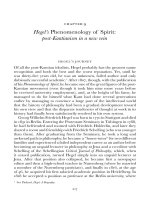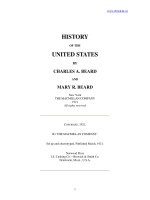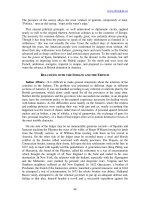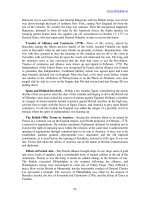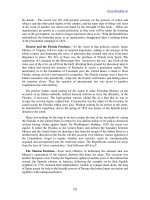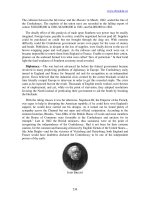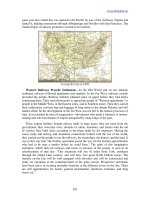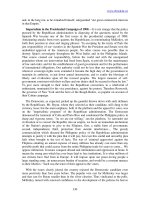physics of semiconductor devices-Jean-Pierre Colinge, Cynthia A.Colinge
Bạn đang xem bản rút gọn của tài liệu. Xem và tải ngay bản đầy đủ của tài liệu tại đây (20.57 MB, 441 trang )
PHYSICS OF SEMICONDUCTOR
DEVICES
PHYSICS OF SEMICONDUCTOR
DEVICES
by
J. P. Colinge
Department of Electrical and Computer Engineering
University of California, Davis
C. A. Colinge
Department of Electrical and Electronic Engineering
California State University
KLUWER ACADEMIC PUBLISHERS
NEW YORK, BOSTON, DORDRECHT, LONDON, MOSCOW
CONTENTS
Preface
xi
1. Energy Band Theory
1.1. Electron in a crystal
1.1.1. Two examples of electron behavior
1.1.1.1. Free electron
1.1.1.2. The particle-in-a-box approach
1.1.2. Energy bands of a crystal (intuitive approach)
1.1.3. Krönig-Penney model
1.1.4. Valence band and conduction band
1.1.5. Parabolic band approximation
1.1.6. Concept of a hole
1.1.7. Effective mass of the electron in a crystal
1.1.8. Density of states in energy bands
1.2. Intrinsic semiconductor
1.3. Extrinsic semiconductor
1.3.1. Ionization of impurity atoms
1.3.2. Electron-hole equilibrium
1.3.3. Calculation of the Fermi Level
1.3.4. Degenerate semiconductor
1.4. Alignment of Fermi levels
Important Equations
Problems
1
1
1
1
3
6
7
15
19
20
21
25
29
31
34
35
37
39
40
43
44
2. Theory of Electrical Conduction
2.1. Drift of electrons in an electric field
2.2. Mobility
2.3. Drift current
2.3.1. Hall effect
2.4. Diffusion current
2.5. Drift-diffusion equations
2.5.1. Einstein relationships
2.6. Transport equations
2.7. Quasi-Fermi levels
Important Equations
Problems
51
51
53
56
57
59
60
60
62
65
67
68
Contents
vi
3. Generation/Recombination Phenomena
3.1. Introduction
3.2. Direct and indirect transitions
3.3. Generation/recombination centers
3.4. Excess carrier lifetime
3.5. SRH recombination
3.5.1. Minority carrier lifetime
3.6. Surface recombination
Important Equations
Problems
73
73
74
77
79
82
86
87
89
89
4. The PN Junction Diode
4.1. Introduction
4.2. Unbiased PN junction
4.3. Biased PN junction
4.4. Current-voltage characteristics
4.4.1. Derivation of the ideal diode model
4.4.2. Generation/recombination current
4.4.3. Junction breakdown
4.4.4. Short-base diode
4.5. PN junction capacitance
4.5.1. Transition capacitance
4.5.2. Diffusion capacitance
4.5.3. Charge storage and switching time
4.6. Models for the PN junction
4.6.1. Quasi-static, large-signal model
4.6.2. Small-signal, low-frequency model
4.6.3. Small-signal, high-frequency model
4.7. Solar cell
4.8. PiN diode
Important Equations
Problems
95
95
97
103
105
107
113
116
118
120
120
121
123
125
126
126
128
128
132
133
133
5. Metal-semiconductor contacts
5.1. Schottky diode
5.1.1. Energy band diagram
5.1.2. Extension of the depletion region
5.1.3. Schottky effect
5.1.4. Current-voltage characteristics
5.1.5. Influence of interface states
5.1.6. Comparison with the PN junction
5.2. Ohmic contact
Important Equations
Problems
139
139
139
142
143
145
146
147
149
150
151
Contents
vii
6. JFET and MESFET
6.1. The JFET
6.2. The MESFET
Important Equations
153
153
159
163
7. The MOS Transistor
7.1. Introduction and basic principles
7.2. The MOS capacitor
7.2.1. Accumulation
7.2.2. Depletion
7.2.3. Inversion
7.3. Threshold voltage
7.3.1 Ideal threshold voltage
7.3.2. Flat-band voltage
7.3.3. Threshold voltage
7.4. Current in the MOS transistor
7.4.1. Influence of substrate bias on threshold voltage
7.4.2. Simplified model
7.5. Surface mobility
7.6. Carrier velocity saturation
7.7. Subthreshold current - Subthreshold slope
7.8. Continuous model
7.9. Channel length modulation
7.10. Numerical modeling of the MOS transistor
7.11. Short-channel effect
7.12. Hot-carrier degradation
7.12.1. Scaling rules
7.12.2. Hot electrons
7.12.3. Substrate current
7.12.4. Gate current
7.12.5. Degradation mechanism
7.13. Terminal capacitances
7.14. Particular MOSFET structures
7.14.1. Non-Volatile Memory MOSFETs
7.14.2. SOI MOSFETs
7.15. Advanced MOSFET concepts
7.15.1. Polysilicon depletion
7.15.2. High-k dielectrics
7.15.3. Drain-induced barrier lowering (DIBL)
7.15.4. Gate-induced drain leakage (GIDL)
7.15.5. Reverse short-channel effect
7.15.6. Quantization effects in the inversion channel
Important Equations
Problems
165
165
170
170
176
178
183
183
184
187
187
192
194
196
199
201
206
208
210
213
216
216
218
218
219
220
221
224
224
228
230
230
231
231
232
233
234
235
236
viii
Contents
8. The Bipolar Transistor
8.1. Introduction and basic principles
8.1.1. Long-base device
8.1.2. Short-base device
8.1.3. Fabrication process
8.2. Amplification using a bipolar transistor
8.3. Ebers-Moll model
8.3.1. Emitter efficiency
8.3.2. Transport factor in the base
8.4. Regimes of operation
8.5. Transport model
8.6. Gummel-Poon model
8.6.1. Current gain
8.6.1.1. Recombination in the base
8.6.1.2. Emitter efficiency and current gain
8.7. Early effect
8.8. Dependence of current gain on collector current
8.8.1. Recombination at the emitter-base junction
8.8.2. Kirk effect
8.9. Base resistance
8.10. Numerical simulation of the bipolar transistor
8.11. Collector junction breakdown
8.11.1. Common-base configuration
8.11.2. Common-emitter configuration
8.12. Charge-control model
8.12.1. Forward active mode
8.12.2. Large-signal model
8.12.3. Small-signal model
Important Equations
Problems
251
251
252
253
256
258
259
268
269
272
273
275
280
280
282
286
290
290
292
295
295
298
298
299
300
301
306
307
309
309
9. Heterojunction Devices
9.1. Concept of a heterojunction
9.1.1. Energy band diagram
9.2. Heterojunction bipolar transistor (HBT)
9.2. High electron mobility transistor (HEMT)
9.3. Photonic Devices
9.3.1. Light-emitting diode (LED)
9.3.2. Laser diode
Problems
315
315
316
320
321
324
324
326
330
Contents
ix
10. Quantum-Effect Devices
10.1. Tunnel Diode
10.1.1. Tunnel effect
10.1.2. Tunnel diode
10.2. Low-dimensional devices
10.2.1. Energy bands
10.2.2. Density of states
10.2.3. Conductance of a 1D semiconductor sample
10.2.4. 2D and 1D MOS transistors
10.3. Single-electron transistor
10.3.1. Tunnel junction
10.3.2. Double tunnel junction
10.3.3. Single-electron transistor
Problems
331
331
331
333
336
337
343
348
350
353
353
355
358
361
11. Semiconductor Processing
11.1. Semiconductor materials
11.2. Silicon crystal growth and refining
11.3. Doping techniques
11.3.1. Ion implantation
11.3.2. Doping impurity diffusion
11.3.3. Gas-phase diffusion
11.4. Oxidation
11.5. Chemical vapor deposition (CVD)
11.5.1. Silicon deposition and epitaxy
11.5.2. Dielectric layer deposition
11.6. Photolithography
11.7. Etching
11.8. Metallization
11.8.2. Metal deposition
11.8.3. Metal silicides
11.9. CMOS process
11.10. NPN bipolar process
Problems
363
363
364
367
367
370
373
374
381
381
382
384
388
391
391
392
393
399
405
12. Annex
Al. Physical Quantities and Units
A2. Physical Constants
A3. Concepts of Quantum Mechanics
A4. Crystallography – Reciprocal Space
A5. Getting Started with Matlab
A6. Greek alphabet
A7. Basic Differential Equations
Index
409
409
410
411
414
418
426
427
431
PREFACE
This Textbook is intended for upper division undergraduate and
graduate courses. As a prerequisite, it requires mathematics through
differential equations, and modern physics where students are introduced
to quantum mechanics. The different Chapters contain different levels of
difficulty. The concepts introduced to the Reader are first presented in a
simple way, often using comparisons to everyday-life experiences such as
simple fluid mechanics. Then the concepts are explained in depth,
without leaving mathematical developments to the Reader's
responsibility. It is up to the Instructor to decide to which depth he or she
wishes to teach the physics of semiconductor devices.
In the Annex, the Reader is reminded of crystallography and quantum
mechanics which they have seen in lower division materials and physics
courses. These notions are used in Chapter 1 to develop the Energy Band
Theory for crystal structures.
An introduction to basic Matlab programming is also included in the
Annex, which prepares the students for solving problems throughout the
text. Matlab was chosen because of its ease of use, its powerful graphics
capabilities and its ability to manipulate vectors and matrices. The
problems can be used in class by the Instructor to graphically illustrate
theoretical concepts and to show the effects of changing the value of
parameters upon the result. We believe it is important for students to
understand and experience a "hands-on" feeling of the consequences of
changing variable values in a problem (for instance, what happens to the
C-V characteristics of a MOS capacitor if the substrate doping
concentration is increased? - What happens to the band structure of a
semiconductor if the lattice parameter is increased? - What happens to
the gain of a bipolar transistor if temperature increases?). Furthermore,
xii
Preface
some Matlab problems make use of a basic numerical, finite-difference
technique in which the "exact" numerical solution to an equation is
compared to a more approximate, analytical solution such as the solution
of the Poisson equation using the depletion approximation.
Chapters 1 to 3 introduce the notion of energy bands, carrier transport
and generation-recombination phenomena in a semiconductor. End-ofchapter problems are used here to illustrate and visualize quantum
mechanical effects, energy band structure, electron and hole behavior, and
the response of carriers to an electric field.
Chapters 4 and 5 derive the electrical characteristics of PN and metalsemiconductor contacts. The notion of a space-charge region is
introduced and carrier transport in these structures is analyzed. Special
applications such as solar cells are discussed. Matlab problems are used to
visualize charge and potential distributions as well as current components
in junctions.
Chapter 6 analyzes the JFET and the MESFET, which are extensions
of the PN or metal-semiconductor junctions. The notions of source, gate,
drain and channel are introduced, together with two-dimensional field
effects such as pinch-off. These important concepts lead the Reader up to
the MOSFET chapter.
Chapter 7 is dedicated to the MOSFET. In this important chapter the
MOS capacitor is analyzed and emphasis is placed on the physical
mechanisms taking place. The current expressions are derived for the
MOS transistor, including second-order effects such as surface channel
mobility reduction, channel length modulation and threshold voltage rolloff. Scaling rules are introduced, and hot-carrier degradation effects are
discussed. Special MOSFET structures such as non-volatile memory and
silicon-on-insulator devices are described as well. Matlab problems are used
to visualize the characteristics of the MOS capacitor, to compare
different MOSFET models and to construct simple circuits.
Chapter 8 introduces the bipolar junction transistor (BJT). The EbersMoll, Gummel-Poon and charge-control models are developed and
second-order effects such as the Early and Kirk effects are described.
Matlab problems are used to visualize the currents in the BJT.
Heterojunctions are introduced in Chapter 9 and several
heterojunction devices, such as the high-electron mobility transistor
Preface
xiii
(HEMT), the heterojunction bipolar transistor (HBT), and the laser
diode, are analyzed.
Chapter 10 is dedicated to the most recent semiconductor devices.
After introducing the tunnel effect and the tunnel diode, the physics of
low-dimensional devices (two-dimensional electron gas, quantum wire and
quantum dot) is analyzed. The characteristics of the single-electron
transistor are derived. Matlab problems are used to visualize tunneling
through a potential barrier and to plot the density of states in lowdimensional devices.
Chapter 11 introduces silicon processing techniques such as oxidation,
ion implantation, lithography, etching and silicide formation. CMOS and
BJT fabrication processes are also described step by step. Matlab problems
analyze the influence of ion implantation and diffusion parameters on
MOS capacitors, MOSFETs, and BJTs.
The solutions to the end-of-chapter problems are available to
Instructors. To download a solution manual and the Matlab files
corresponding to the end-of-chapter problems, please go to the following
URL: />This Book is dedicated to Gunner, David, Colin-Pierre, Peter, Eliott
and Michael. The late Professor F. Van de Wiele is acknowledged for his
help reviewing this book and his mentorship in Semiconductor Device
Physics.
Cynthia A. Colinge
California State University
Jean-Pierre Colinge
University of California
Chapter 1
ENERGY BAND THEORY
1.1. Electron in a crystal
This Section describes the behavior of an electron in a crystal. It will
be demonstrated that the electron can have only discrete values of
energy, and the concept of "energy bands" will be introduced. This
concept is a key element for the understanding of the electrical properties
of semiconductors.
1.1.1. Two examples of electron behavior
An electron behaves differently whether it is in a vacuum, in an atom,
or in a crystal. In order to comprehend the dynamics of the electron in a
semiconductor crystal, it is worthwhile to first understand how an electron
behaves in a simpler environment. We will, therefore, study the
"classical" cases of the electron in a vacuum (free electron) and the
electron confined in a box-like potential well (particle-in-a-box).
1.1.1.1. Free electron
The free electron model can be applied to an electron which does not
interact with its environment. In other words, the electron is not
submitted to the attraction of the atoms in a crystal; it travels in a
medium where the potential is constant. Such an electron is called a free
electron. For a one-dimensional crystal, which is the simplest possible
structure imaginable, the time-independent Schrödinger equation can be
written for a constant potential V using Relationship A3.12 from Annex
3. Since the reference for potential is arbitrary the potential can be set
equal to zero (V = 0) without losing
The time-independent
Schrödinger equation can, therefore, be written as:
2
Chapter 1
where E is the electron energy, and m is its mass. The solution to
Equation 1.1.1 is :
where:
Equation 1.1.2 represents two waves traveling in opposite directions.
represents the motion of the electron in the +x direction, while
represents the motion of the electron in the -x direction.
What is the meaning of the variable k? At first it can be observed that the
unit in which k is expressed is
or
k is thus a vector belonging to
the reciprocal space. In a one-dimensional crystal, however, k can be
considered as a scalar number for all practical purposes. The momentum
operator,
of the electron, given by relationship A3.2, is:
Considering an electron moving along the +x direction in a onedimensional sample and applying the momentum operator to the wave
function
we obtain:
The eigenvalues of the operator px are thus given by:
Hence, we can conclude that the number k, called the wave number, is
equal to the momentum of the electron, within a multiplication factor
In classical mechanics the speed of the electron is equal to v=p/m, which
yields
We can thus relate the expression of the electron energy,
given by Expression 1.1.3, to that derived from classical mechanics:
The energy of the free electron is a parabolic function of its momentum
k, as shown in Figure 1.1.This result is identical to what is expected from
classical mechanics considerations: the "free" electron can take any value
of energy in a continuous manner. It is worthwhile noting that electrons
1. Energy Band Theory
3
with momentum k or -k have the same energy. These electrons have the
same momentum but travel in opposite directions.
Another interpretation can be given to k. If we now consider a threedimensional crystal, k is a vector of the reciprocal space. It is the called
the wave vector. Indeed, the expression exp(jkr), where r=(x,y,z) is the
position of the electron, and represents a plane spatial wave moving in
the direction of k. The spatial frequency of the wave is equal to k, and its
spatial wavelength is equal to
1.1.1.2. The particle-in-a-box approach
After studying the case of a free electron, it is worthwhile to consider
a situation where the electron is confined within a small region of space.
The confinement can be realized by placing the electron in an infinitely
deep potential well from which it cannot escape. In some way the
electron can be considered as contained within a box or a well surrounded
by infinitely high walls (Figure 1.2). To some limited extent, the particlein-a-box problem resembles that of electrons in an atom, where the
attraction from the positively charge nucleus creates a potential well that
"traps" the electrons.
4
Chapter 1
By definition the electron is confined inside the potential well and
therefore, the wave function vanishes at the well edges: thus the boundary
conditions to our problem are:
Within the
potential well
where V = 0, the time-independent Schrödinger
equation can be written as:
which can be rewritten in the following form:
The solution to this homogenous, second-order differential equation is:
Using the first boundary condition
the second boundary condition
therefore:
we obtain B = 0. Using
we obtain A sin(ka) = 0 and
1. Energy Band Theory
5
with
n = 1,2,3,...
(1.1.9)
The wave function is thus given by:
and the energy of the electron is:
This result is quite similar to that obtained for a free electron, in both
cases the energy is a function of the squared momentum. The difference
resides in the fact that in the case of a free electron, the wave number k
and the energy E can take any value, while in the case of the particle-ina-box problem, k and E can only take discrete values (replacing k by
in Expression 1.1.3 yields Equation 1.1.11). These values are fixed by the
geometry of the potential well. Intuitively, it is interesting to note that if
the width of the potential well becomes very large
the different
values of k become very close to one another, such that they are no
longer discrete values but rather form a continuum, as in the case for the
free electron.
Which values can k take in a finite crystal of macroscopic dimensions?
Let us consider the example of a one-dimensional linear crystal having a
length L (Figure 1.3). If we impose
and
as in the
case of the particle-in-the-box approach, Relationships 1.1.9 and 1.1.11
tell us that the permitted values for the momentum and for the energy of
the electron will depend on the length of the crystal. This is clearly
unacceptable for we know from experience that the electrical properties
of a macroscopic sample do not depend on its dimensions.
Much better results are obtained using the Born-von Karman boundary
conditions, referred to as cyclic boundary conditions. To obtain these
conditions, let us bend the crystal such that x = 0 and x = L become
coincident. From the newly obtained geometry it becomes evident that
for any value of x, we have the cyclical boundary conditions:
Using the free-electron wave function (Expression 1.1.2), and
taking into account the periodic nature of the problem, we can write:
which imposes:
where n is an integer number.
In the case of a three-dimensional crystal with dimensions
Born-von Karman boundary conditions can be written as follows:
the
6
where
Chapter 1
are integer numbers.
1.1.2. Energy bands of a crystal (intuitive approach)
In a single atom, electrons occupy discrete energy levels. What
happens when a large number of atoms are brought together to form a
crystal? Let us take the example of a relatively simple element with low
atomic number, such as lithium (Z=3). In a lithium atom, two electrons of
opposite spin occupy the lowest energy level (1s level), and the remaining
third electron occupies the second energy level (2s level). The electronic
configuration is thus
All lithium atoms have exactly the same
electronic configuration with identical energy levels. If an hypothetical
molecule containing two lithium atoms is formed, we are now in the
presence of a system in which four electrons "wish" to have an energy
equal to that of the 1s level. But because of the Pauli exclusion principle,
which states that only two electrons of opposite spins can occupy the
same energy level, only two of the four 1s electrons can occupy the 1s
level. This clearly poses a problem for the molecule. The problem is
solved by splitting the 1s level into two levels having very close, but
nevertheless different energies (Figure 1.4).
1. Energy Band Theory
7
If a crystal of lithium containing N number of atoms is now formed, the
system will contain N number of 1s energy levels. The same consideration
is valid for the 2s level. The number of atoms in a cubic centimeter of a
crystal is on the order of
As a result, each energy level is split
into
distinct energy levels which extend throughout the crystal.
Each of these levels can be occupied by two electrons by virtue of the
Pauli exclusion principle. In practice, the energy difference between the
highest and the lowest energy value resulting from this process of splitting
an energy level is on the order of a few electron-volts; therefore, the
energy difference between two neighboring energy levels is on the order
of
eV. This value is so small that one can consider that the energy
levels are no longer discrete, but form a continuum of permitted energy
values for the electron. This introduces the concept of energy bands in a
crystal. Between the energy bands (between the 1s and the 2s energy
bands in Figure 1.4) there may be a range of energy values which are not
permitted. In that case, a forbidden energy gap is produced between
permitted energy bands. The energy levels and the energy bands extend
throughout the entire crystal. Because of the potential wells generated by
the atom nuclei, however, some electrons (those occupying the 1s levels)
are confined to the immediate neighborhood of the nucleus they are
bound to. The electrons of the 2s band, on the other hand, can overcome
nucleus attraction and move throughout the crystal.
1.1.3. Krönig-Penney model
Semiconductors, like metals and some insulators, are crystalline
materials. This implies that atoms are placed in an orderly and periodic
manner in the material (see Annex A4). While most usual crystalline
materials are polycrystalline, semiconductor materials used in the
8
Chapter 1
electronics industry are single-crystal. These single crystals are almost
perfect and defect-free, and their size is much greater than any of the
microscopic physical dimensions which we are going to deal with in this
chapter.
In a crystal each atom of the crystal creates a local potential well which
attracts electrons, just like in the lithium crystal described in Figure 1.4.
The potential energy of the electron depends on its distance from the
atom nucleus. Electrostatics provides us with a relationship establishing
the potential energy resulting from the interaction between an electron
carrying a charge -q and a nucleus bearing a charge +qZ, where Z is the
atomic number of the atom and is equal to the number of protons in the
nucleus:
In this relationship x is the distance between the electron and the nucleus,
V(x) is the potential energy and is the permittivity of the material under
consideration. Equation 1.1.14 ignores the presence of other electrons,
such as core electrons "orbiting" around the nucleus. These electrons
actually induce a screening effect between the nucleus and outer shell
electrons, which reduces the attraction between the nucleus and higherenergy electrons. The energy of the electron as a function of its distance
from the nucleus is sketched in Figure 1.5.
How will an electron behave in a crystal? In order to simplify the
problem, we will suppose that the crystal is merely an infinite, one-
1. Energy Band Theory
9
dimensional chain of atoms. This assumption may seem rather coarse, but
it preserves a key feature of the crystal: the periodic nature of the
position of the atoms in the crystal. In mathematical terms, the
expression of the periodic nature of the atom-generated potential wells
can be written as:
where a+b is the distance between two atoms in the x-direction (Figure
1.6).
The periodic nature of the potential has a profound influence on the wave
function of the electron. In particular, the electron wave function must
satisfy the time-independent Schrödinger equation whenever x+a+b is
substituted for x in the operators that act on
This condition is
obtained if the wave function satisfies the Bloch theorem, which can be
formulated as follows:
If V(x) is periodic such that V(x+a+b) =V(x),
then
(1.1.16)
A second formulation of the theorem is:
If V(x) is periodic such that V(x+a+b) =V(x),
then
with u(x+a+b) = u(x).
These two formulations are equivalent since
Since the potential in the crystal, V(x), is a rather complicated function of
x, we will use the approximation made by Krönig and Penney in 1931, in
which V(x) is replaced by a periodic sequence of rectangular potential
wells.[4] This approximation may appear rather crude, but it preserves
the periodic nature of the potential variation in the crystal while allowing
a closed-form solution for
The resulting potential is depicted in
10
Chapter 1
Figure 1.7, and the following notations will be used: the inter-atomic
distance is a+b, the potential energy near an atom is
and the potential
energy between atoms is
Both
and
are negative with respect to
an arbitrary reference energy, V=0, taken outside the crystal. We will
study the behavior of an electron with an energy E lying between
and
. This case is similar to a 1s electron previously shown
for lithium.
In region I (0
and the time-
In region II (-b
and the time-
The solution to these homogenous second-order differential equations are:
and
Note that and are real numbers. The periodic nature of the crystal
lattice suggests that the wave function satisfies the Bloch theorem
(1.1.16) and can be written in the following form:
1. Energy Band Theory
where
11
is a periodic function with period a + b, which imposes
One can thus write:
and
Boundary conditions must be used to calculate the four integration
constants A, B, C and D of Equations 1.1.19 and 1.1.20. This can be done
by imposing the condition that the wave function,
and its first
derivative,
are continuous at x=0 and x=a. By doing so one
obtains the following equations:
is continuous at x=0. Thus
which yields:
is continuous at x=0. Therefore,
is continuous at x=a giving
theorem (Equation 1.1.16) at x=a we have
which yields:
is continuous at x=a giving
Bloch's theorem:
exp(jk(a+b)) we obtain:
Using the Bloch
Using
Equations (1.1.23) to (1.1.26) form a system of four equations with four
unknowns: A, B, C and D. This system can be written in a matrix form:
In order to obtain a non-trivial solution for A, B, C and D, i.e. a solution
different from A=B=C=D=0, the determinant of the 4×4 matrix must be
equal to zero, which is equivalent to writing (see Problem 1.5):
12
Chapter 1
The right-hand term of this equation depends only on E, through and
(Expressions 1.1.19 and 1.1.20). Let us call this term P(E) and rewrite
Expression 1.1.28 in the following form:
The right-hand side of Equation 1.1.29 is sketched as a function of energy
in Figure 1.8. Because the argument in the exponential term of (1.1.16)
must be imaginary, k must be real. Therefore, simultaneous solution of
both left- and right-hand side of Equation 1.1.29 imposes that
1. This defines permitted values of energy forming the energy bands, and
forbidden values of energy constituting forbidden energy bands. This
important result is the same to that intuitively unveiled in Section 1.1.2:
in a crystal there are bands of permitted energy values separated by bands
of forbidden energy values.
Note: In the case when the electron energy is greater than
value and Equation 1.1.20 becomes:
has a positive
In that case the Krönig-Penney model yields an equation different from Relationship
1.1.28; however, the same general conclusion can be drawn, i.e., the existence of
permitted and for bidden energy bands.
1. Energy Band Theory
13
Using Expression 1.1.28 the E(k) diagram can be plotted as well. Figure
1.9 presents the energy of the electron as a function of the wave number
k. The E(k) diagram for a free electron is also shown. It can be observed
that the energy of the electron in a crystal coarsely represents the same
dependence on k as that of a free electron. The main differences reside in
the existence of forbidden energy values and curvatures of each segment
of the E(k) curves.
Chapter 1
14
Because of the periodicity of the crystal lattice (period = a + b), the
periodicity of the reciprocal lattice (k-space) is
be extended from
The E(k) curve can
with a periodicity of
which
yields the permitted energy values for the entire one-dimensional crystal
(Figure 1.10).
The E(k) curves shown in Figure 1.10 can be limited to k-values ranging
from
to
without any loss of information. This particular
region of the k-space is called the first Brillouin zone. The second
Brillouin zone extends from
third zone extends from
to
to
and from
and from
to
to
the
etc.
Applying the Born-von Karman boundary conditions (Expression 1.1.12)
to the one-dimensional crystal yields the values for k:
where N is the number of lattice cells in the crystal (or the number of
atoms in the case of a one-dimension crystal). The length of the crystal is
equal to N(a+b). Since we limit our study to the first Brillouin zone, the kvalues which have to be considered are given by the following
relationship:
duplicate of the
(the value
is excluded because it is a
wave number). The corresponding values for n
range from -N/2 to (N/2-1). Therefore, the values of k to consider are:
There are thus N wave numbers in the first Brillouin zone, which
corresponds to the number of elementary lattice cells. For every wave
number there is a permitted energy value in each energy band. By virtue
of the Pauli exclusion principle, each energy band can thus contain a
maximum of 2N electrons.
The one-dimensional volume of the first Brillouin zone is equal to
Since it contains N k-values, the density of k-values in the first
Brillouin zone is given by:
